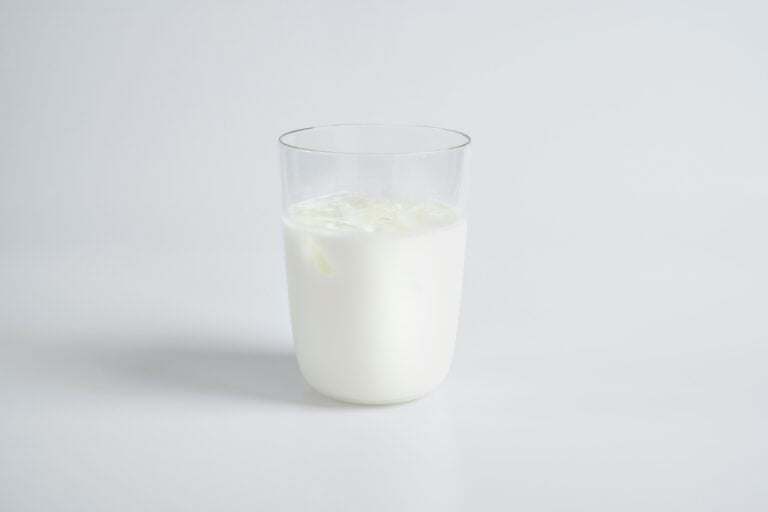Skim milk, also known as fat-free or non-fat milk, is a popular dairy product among health-conscious consumers.
This blog post will delve into what skim milk is, its nutritional profile, benefits, disadvantages, price variations across different countries, and how it compares to other types of milk.
Additionally, we’ll cover how to make skim milk at home and the difference between skim milk and toned milk.
What is Skim Milk?
Skim milk has had most of its fat removed, typically containing less than 0.5% fat.
The process involves skimming the cream off the top of whole milk, resulting in a lighter, lower-calorie beverage. It retains essential nutrients like protein, calcium, and vitamins but lacks the fat content found in whole milk.
Nutritional Profile of Skim Milk
Skim milk is rich in nutrients and offers a range of health benefits. Here’s a breakdown of its nutritional content (240 ml) serving:
| Nutritional Value (per 240 ml) | |
| Carbohydrate | 12 g |
| Protein | 8 g |
| Fat | 0.2 g |
| Calories | 83 |
| Calcium | 300 mg |
| Vitamin A | 344 mcg |
| Vitamin C | 2.5mg |
Benefits of Skim Milk
Low in Calories: Ideal for those on a calorie-restricted diet.
Rich in Protein: Supports muscle growth and repair.
High in Calcium: Essential for bone health.
Fortified with Vitamin D: Aids in calcium absorption and bone health.
Low in Saturated Fat: Reduces the risk of heart disease.
Advantages & Disadvantages of Skim Milk
| Advantages | Disadvantages |
| Weight Management Lower calorie content helps in weight control. | Lacks Fat-Soluble Vitamins Without fat, vitamins A, D, E, and K absorption is reduced. |
| Cardiovascular Health Lower saturated fat reduces heart disease risk. | Less Flavorful Some people find skim milk less tasty than whole milk. |
| Versatility Can be used in cooking and baking without significantly altering the nutritional profile. | May Not Be Satiating Lower fat content may not keep you full as long as whole milk. |
Price Variations of Skim Milk in Different Countries
The price of skim milk varies globally, influenced by factors such as production costs, demand, and local economic conditions. Here’s a snapshot of skim milk prices per liter in different countries:
| Price Variations of Skim Milk in Different Countries | |
| United States | $1.00 – $1.50 |
| Canada | $1.30 – $1.80 |
| United Kingdom | £0.90 – £1.30 |
| Australia | AUD 1.20 – AUD 1.60 |
| India | ₹40 – ₹60 |
| China | CNY 7 – CNY 10 |
Difference Between Skim Milk and Whole Milk
Fat Content: Skim milk has less than 0.5% fat, while whole milk contains about 3.5% fat.
Calorie Count: Skim milk is lower in calories compared to whole milk.
Nutrient Absorption: Whole milk’s fat aids in the absorption of fat-soluble vitamins, which skim milk lacks.
How to Make Skim Milk at Home
Making skim milk at home is simple. Follow these steps:
Start with Whole Milk: Use fresh whole milk for the best results.
Let It Settle: Allow the milk to sit in the refrigerator for at least 24 hours. The cream will rise to the top.
Skim the Cream: Gently skim off the top layer of cream using a ladle or spoon.
Store the Skim Milk: Pour the skimmed milk into a clean container and refrigerate.
Conclusion
Skim milk is a popular choice for those seeking a lower-calorie, fat-free alternative to whole milk. It offers several health benefits, including being rich in protein and calcium while being low in saturated fat.
However, it lacks the fat-soluble vitamins present in whole milk, and some may find it less flavorful and less satiating. The price of skim milk varies globally, reflecting local economic factors.
Understanding the differences between skim milk, whole milk, and toned milk can help consumers make informed choices based on their dietary needs and preferences.
Whether you buy skim milk from the store or make it at home, it’s a versatile ingredient that can be used in various culinary applications.
By incorporating skim milk into your diet, you can enjoy its nutritional benefits while managing your calorie and fat intake.

1 thought on “Skim Milk: Nutrition and Benefits”